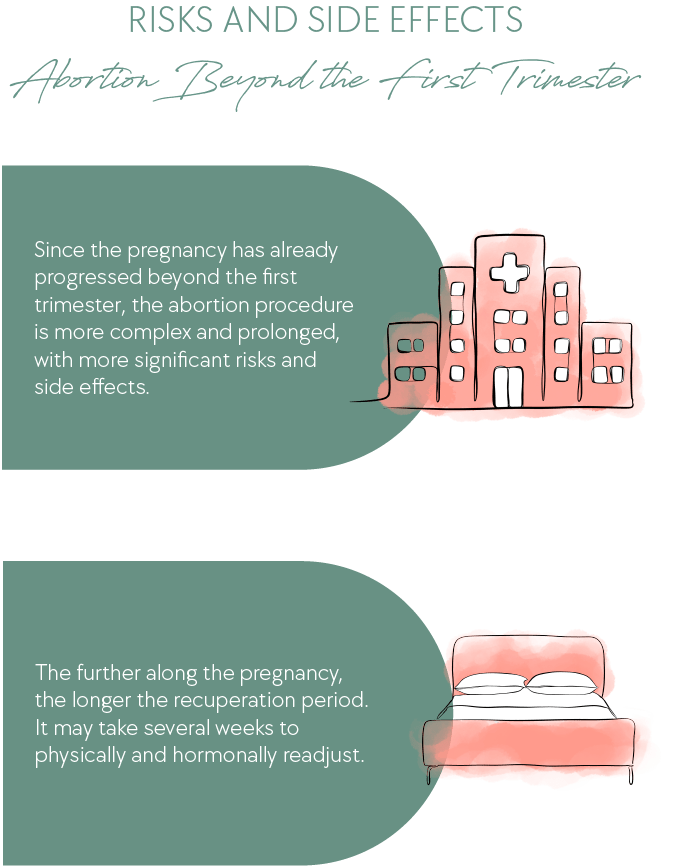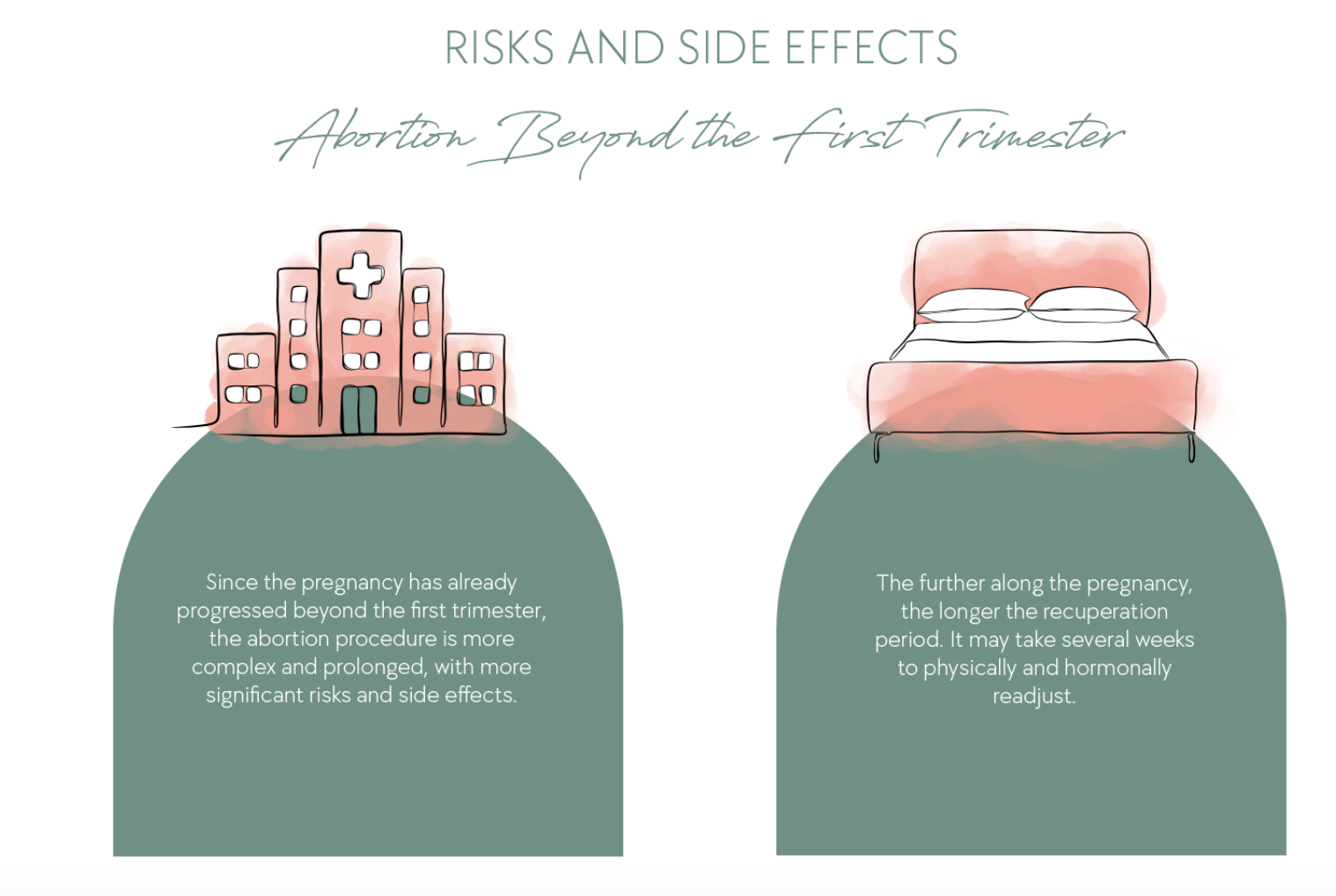Abortion by D&X
🏥 Abortion Methods: What Do I Need to Know? — Take the quiz
- Intact D&E is a surgical procedure in which the cervix is dilated, and the fetus is extracted from the uterus largely intact.
- This method is only permitted in the US if fetal demise is ensured by injection before extraction or if necessary to save the woman's life.
- The rate of complications lies at 5% and increases with fetal size.
Abortion Methods: What Do I Need to Know? Quiz
Considering abortion and wondering what method to select? Answer three multiple-choice questions about your situation and receive a professional evaluation within seconds on your screen!
What Is an Intact D&E?
Intact dilation and extraction, aka D&X, IDX, or intact D&E, is a second and third-trimester surgical abortion method. It is termed a partial-birth abortion if used without administering an injection to kill the fetus. Using this method for a live fetus is banned in the US by the federal Partial-Birth Abortion Ban Act of 2003. In other countries, no such ban exists. The performance of an intact D&E depends on staying within the legal time limits of the country and the availability of experts who are willing and able to perform this procedure.
- Find out if second-trimester abortions are legal in your area by going to Until When Can I Get an Abortion?
- Go to Abortion Methods to see how the different methods compare.
- Go to Late-Term Abortion — to learn about exceptions, regulations, and procedures.
In an intact D&E, the fetus is removed feet-first (breech position). When the head reaches the cervical opening, the brain is suctioned out and the skull collapses, making the passage through the cervix and vagina possible.
An intact D&E abortion is usually an outpatient procedure. While the surgery takes only 30 minutes, the entire procedure is completed within two to three days.
This abortion method requires greater cervical dilation than all other surgical abortion procedures. The cervix is dilated slowly over several days until it reaches 2-5cm.
Procedural protocols increase the cost of an abortion.
- Wondering how much you should be expect to pay? Go to How Much Does an Abortion Cost.
Intact D&E Abortion: Step by Step
Intact D&Es are completed in two steps:
1. Dilation Stage — (2–3 days before the procedure)
Consent Forms and Payment: By law, abortion is a free choice and may only be performed after receiving written consent from the woman.
- Go to Coerced Abortion if you feel pressured into having an abortion.
Bloodwork and Ultrasound: Blood is drawn to determine the patient's Rh factor and blood type for possible blood transfusions. Women who are Rh-negative will be given a RhoGam injection.
A pre-abortion ultrasound reveals the week of pregnancy and identifies the position of the fetus and placenta.Feticide: A medicine may be injected through the woman's abdomen or vagina to cause fetal death and soften its bones. This is a mandatory step in compliance with the Partial-Birth Abortion Ban Act in the US.
Antibiotics: A single dose of oral antibiotics is administered as a precaution against infection.
Dilation: The cervix is softened and gradually dilated (opened) over two or more days using osmotic dilators. Seaweed stalks (laminaria) or hydrogel rods are used for this purpose as they slowly expand by absorbing the moisture in the woman's cervix. After the placement of the dilators, the woman usually leaves the clinic until the day of her procedure.
Many women experience these two days as emotionally exhausting. Going through this stage can feel alienating leading to emotional numbness and loneliness.
2. Intact Evacuation Stage (2–3 days later)
Medicinal Dilation: Misoprostol (Cytotec®) may be given several hours before surgery to complete cervical ripening.
Removal of Dilators: The osmotic dilators are removed from the cervix.
Ultrasound: An ultrasound is performed to confirm the absence of a fetal heartbeat and locate the position of the fetus.
Anesthesia: Intact D&Es are typically performed using a local anesthetic injected into the cervix and intravenous conscious sedation. Medication that slows uterine bleeding is also administered to reduce blood loss.
- Are you looking for information about options for sedation or anesthesia? Go to What Type of Anesthesia?
Removal of Fetus and Placenta: The doctor uses a speculum to open the woman's vagina, making her cervix visible. A tube is inserted into her uterus, by which all amniotic fluid is suctioned out. Using extraction forceps, the surgeon then grasps one or both legs of the fetus and pulls them out of the cervix until the head is lodged inside the uterus.
A hole is made in the base of the skull, and the brain is suctioned out. This decompression causes the head to collapse, making it possible for the fetus to pass through the cervix, otherwise intact. Next, the placenta is removed.
After the intact extraction, suction and curettage ensure a complete abortion, which is then confirmed by ultrasound.Recovery Room: Immediately after the procedure, the patient will be observed until deemed fit for discharge. A follow-up appointment is scheduled, and a partner, friend, or family member will need to drive the patient home.
What to Expect After an Intact D&E
Side Effects
After an intact D&E, the uterus may bleed for up to two weeks. Cramping may continue for several weeks, reducing the uterus to its pre-pregnancy size. Breasts may swell, hurt, and leak colostrum.
⚠️ Menstruation should resume after four to eight weeks, but conception is possible before your first period.
Things to Avoid
Since the cervix stays slightly open for three to four weeks, it is essential to refrain from the following activities to avoid infection:
- sexual intercourse
- tampons
- swimming pools/bathtubs
- sauna visits
Potential Risks of an Intact D&E
Before the procedure, the surgeon will provide information on the possible risks of an intact D&E abortion. Approximately 5% of women encounter complications such as cervical laceration, uterine perforation, infection, extramural delivery (delivery due to dilation before the surgery), and hemorrhage.


ℹ️ For more information, go to Risks and Side Effects of Abortion.
Apart from considering the physical risks, the possible emotional repercussions need to be taken into account. Slowing down the decision-making process to evaluate whether this is the right path for you is essential for your emotional well-being. In counseling, we regularly encounter women who struggle with their choice after having had an abortion. If you still feel unsure, take a step back until you feel certain.
- Will abortion affect me long term? Take the Test
Reasons for an Intact D&E Abortion
The reasons women pursue an intact D&E abortion are as unique as their lived experiences.
Your doctor may have recommended an intact D&E as the risk of cervical lacerations and retention of fetal tissue is reduced compared to a dilation and evacuation abortion. However, the overall percentage of complications is identical.
Perhaps you have received the heartbreaking news of congenital anomalies and are wondering whether to have an abortion that leaves the body intact for a post-abortion autopsy.
- Use our Fetal Defect Abortion Test to guide you in the decision-making process.
Maybe you are encountering a severe medical issue that is putting your life or health at risk and are hoping for closure by being able to view the remains.
- Use the information provided in Abortion for the Health of the Mother as you determine your next steps.
Perhaps you just found out you were pregnant or could not get an appointment sooner because of finances or abortion restrictions. You may be thinking about having the procedure done in another state or country.
Or maybe an unexpected crisis in your relationship is causing you to doubt whether to go through with the pregnancy.
Where Do I Go from Here?
While our goal is to provide helpful information, your questions most likely go beyond the scope of which method to choose.
Your concerns matter because you matter!
Are you pressured by your circumstances or medical provider to make a quick decision? Most late-term abortion methods, including intact D&E, require several days of preparation. Therefore, this is unlikely to be a medical emergency. Allow yourself the time to make a decision that corresponds with who you are.
Allow us to be a neutral sounding board for you.
Our professional counselors have designed judgment-free tests to guide you in your decision-making process. Why not give them a try?
- ⛑ Where do I go from here? — Quick Answers Quiz
- ⚖️ Wondering whether to have an abortion or not? Take the Abortion Test
You may also like:






